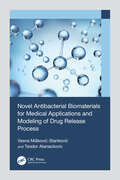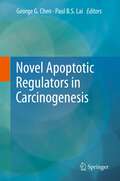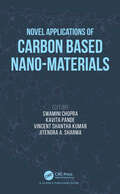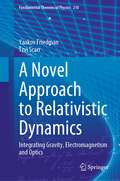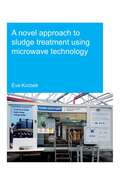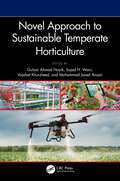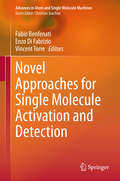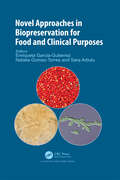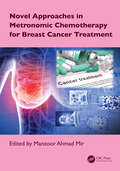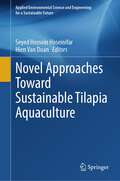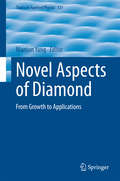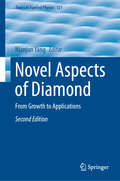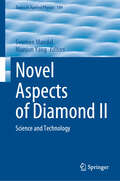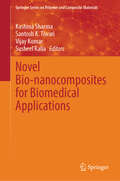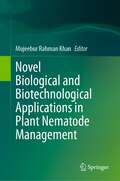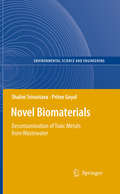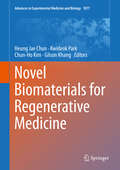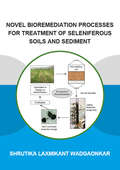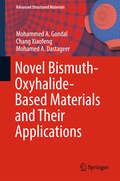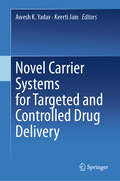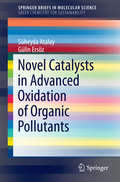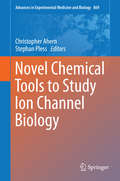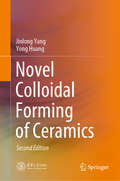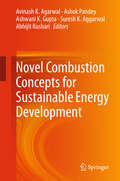- Table View
- List View
Novel Antibacterial Biomaterials for Medical Applications and Modeling of Drug Release Process
by Vesna Mišković-Stanković Teodor AtanackovicThis book provides a comprehensive review of synthesis and physicochemical and biological characterization of novel antibacterial biomaterials produced according to original procedures and aimed at medical applications such as wound dressing, soft and hard tissue implants, drug delivery devices, and carriers for cell cultivation. It is intended for all researchers working in the fields of biomaterials and biomedical engineering, as well as medical professionals, science and engineering graduate students, academics, and industrial researchers. Includes in-depth discussions on synthesis and physicochemical characterization of novel poly vinyl alcohol-based hydrogels aimed at wound dressings and soft tissue implants Explores synthesis and physicochemical characterization of novel bioceramic hydroxyapatite-based coatings on metal surface aimed for hard tissue implants Reviews cytotoxicity and antibacterial activity of novel poly vinyl alcohol-based hydrogels aimed for wound dressing and soft tissue implants Discusses cytotoxicity and antibacterial activity of bioceramic hydroxyapatite-based coatings on metal surface aimed for hard tissue implants Provides original fractional derivative models of drug release process from hydrogels and bioceramic coatings on metal surface and explores diffusion mechanism
Novel Apoptotic Regulators in Carcinogenesis
by Paul B.S. Lai George G. ChenOur recent understanding of the cellular and molecular defects and the regulation of the apoptotic signalling pathways has resulted in rationally designed anticancer strategies and the development of novel agents that regulates apoptosis. A comprehensive review of all apoptotic-related anticancer therapies is not the purpose of this book. However, in the volume of this book with 11 chapters, we have described a number of novel apoptotic regulators that have shown promising value and also great feasibility for cancer treatment. These novel agents either occur naturally or are chemically synthesized. While we are excited about the discovery and development of these novel apoptotic regulators as potential anticancer agents, a degree of caution should be always borne in mind when interpreting the success of preclinical pro-apoptotic candidates since potential problems inevitably lie ahead. These problems usually include target specificity, unanticipated toxicity, compound stability, formulation issues, pharmacokinetic and pharmacodynamic profiles. Nevertheless, we believe that this collection of 11 chapters by established leaders in the area of apoptosis will be of great interest to not only academics working in the field of cancer research and apoptosis but also pharmaceutical and pharmacological industries that . We are looking forward to the further development to push these potential agents toward clinical stage.
Novel Applications of Carbon Based Nano-materials
by Swamini Chopra Kavita Pande Vincent Shantha Kumar Jitendra A. Sharma"There’s plenty of room at the bottom" - Richard Feynman’s legendary sentence has practically teleported the world into the age of Nano-technology over the last couple of decades. As nano-materials started drawing extensive attention, the use of nano-technology has opened many possibilities for humans. Carbon based nano-materials are an example of such prominent class of materials, which have an enormous potential to fit a wide range of applications, ranging from the energy sector to aircraft and automotive sector to bio-medical sector, etc. The book Novel Applications of Carbon Based Nano-Materials summarizes state-of-the-art studies focusing on various applications of carbon allotropes, considering the energy and environmental benefits and the socio-economic impact of the developed systems, all at the same time.
A Novel Approach to Relativistic Dynamics: Integrating Gravity, Electromagnetism and Optics (Fundamental Theories of Physics #210)
by Yaakov Friedman Tzvi ScarrThis self-contained monograph provides a mathematically simple and physically meaningful model which unifies gravity, electromagnetism, optics and even some quantum behavior. The simplicity of the model is achieved by working in the frame of an inertial observer and by using a physically meaningful least action principle.The authors introduce an extension of the Principle of Inertia. This gives rise to a simple, physically meaningful action function. Visualizations of the geometryare obtained by plotting the action function. These visualizations may be used to compare the geometries of different types of fields. Moreover, a new understanding of the energy-momentum of a field emerges.The relativistic dynamics derived here properly describes motion of massive and massless objects under the influence of a gravitational and/or an electromagnetic field, and under the influence of isotropic media.The reader will learn how to compute the precession of Mercury, the deflection of light, and the Shapiro time delay. Also covered is the relativistic motion of binary stars, including the generation of gravitational waves, a derivation of Snell's Law and a relativistic description of spin. We derive a complex-valued prepotential of an electromagnetic field. The prepotential is similar to the wave function in quantum mechanics. The mathematics is accessible to students after standard courses in multivariable calculus and linear algebra. For those unfamiliar with tensors and the calculus of variations, these topics are developed rigorously in the opening chapters. The unifying model presented here should prove useful to upper undergraduate and graduate students, as well as to seasoned researchers.
A Novel Approach to Sludge Treatment Using Microwave Technology (IHE Delft PhD Thesis Series)
by Eva KocbekSludge transportation costs can represent a large fraction of the expenses associated with municipal and faecal sludge management. These costs can be mitigated through the use of thermal drying approaches to reduce the sludge volume. This thesis described the application of a novel microwave-based pilot-scale unit as an alternative technology for the sanitisation and drying of sludge from municipal wastewater treatment plants and on-site sanitation facilities. The potential economic benefits of volumetric heating, moisture levelling, and increased liquid and vapour migration from the interior to the surface of the product underpins the increasing interest in the use of microwave technology during sludge treatment processes. According to the findings of this study, these factors lead to faster processing times, improved drying rates, and a reduced physical footprint. Furthermore, microwave technology operates as a standalone treatment unit. When coupled with mechanical dewatering techniques and membrane separation technology, it can increase the reliability of the technology employed in the treatment of sludge while recovering valuable resources through an agricultural or thermochemical application such as (co-) combustion. The results of this work demonstrate the strong feasibility of applying microwave-based technology within initiatives designed to protect the environment and safeguard public health.
Novel Approach to Sustainable Temperate Horticulture
by Gulzar Ahmad Nayik Mohammad Javed Ansari Vajahat Khursheed Sajad H. WaniIn the current scenario, marked by a continual improvement in living standards, it becomes imperative to boost the productivity as well as the efficiency of agriculture, especially horticulture, which holds the potential for significant economic prosperity aligning with Sustainable Development Goal number 8, "Decent Work and Economic Growth". Modern technological interventions, such as geospatial technology and geographic information system (GIS) technology, can be harnessed to yield effective results in addressing challenges and providing enhanced decision support, particularly in the planning of horticultural resource management. Cultivation and production of fresh produce face several challenges, including prolonged juvenile phases and reproductive cycles with extended breeding periods, creating bottlenecks in the process. The evolving trends in biotechnology offer promising solutions for improving the selection of desirable traits. Biotechnological techniques aimed at improving fruit efficiency encompass tissue culture, induction of genetic variability, germplasm conservation, and molecular breeding/genomics. These methods involve the study of genetic diversity, DNA fingerprinting, and Quantitative Trait Loci (QTL) analysis for marker-assisted selection. Over the past few decades, the global population has consistently risen, raising concerns about the ability of the current food system to adequately feed the anticipated 10 billion people in the next 30 years. While this challenge is deemed achievable, certain changes in both food production and consumption systems are essential to ensure sustainability, reduce food loss and waste, and contribute to a global shift toward healthier and more sustainable diets. Implementing sustainable models of crop production represents a significant undertaking. To address the growing food demand amid deteriorating production environments, there is a need for promising technologies and effective management options to enhance productivity.This book is poised to be a valuable resource for horticultural scientists operating in universities, government agencies, and research centers, offering insights into achieving sustainable cultivation practices for fruits. It stands out as the first of its kind, providing in‑depth knowledge on environmentally friendly methods for cultivating temperate fruit crops, to reduce harmful emissions and pollution. This book will delve into the application of geographic information system (GIS) for estimating horticulture area expansion and crop yield. Additionally, it will encompass recent biotechnological interventions in horticulture, circular agriculture models, and emerging non‑thermal food preservation techniques as significant components.Features: Aims to provide a comprehensive and integrated overview of current techno-statistical techniques employed in horticulture, delving into the associated livelihood benefits derived from the practice. Explores the novel geographical trends to identify the site suitability indices of several temperate fruits. Offers a comprehensive and integrated exploration of recent trends in biotechnological approaches aimed at enhancing food production, quality, and safety.
Novel Approaches for Single Molecule Activation and Detection
by Fabio Benfenati Enzo Di Fabrizio Vincent TorreHow can we obtain tools able to process and exchange information at the molecular scale? In order to do this, it is necessary to activate and detect single molecules under controlled conditions. This book focuses on the generation of biologically-inspired molecular devices. These devices are based on the developments of new photonic tools able to activate and stimulate single molecule machines. Additionally, new light sensitive molecules can be selectively activated by photonic tools. These technological innovations will provide a way to control activation of single light-sensitive molecules, allowing the investigation of molecular computation in a biological environment.
Novel Approaches in Biopreservation for Food and Clinical Purposes
by Enriqueta Garcia-Gutierrez Natalia Gomez-Torres Sara ArbuluThe aim of "Novel Approaches in Biopreservation for Food and Clinical Purposes" is to provide cutting-edge information on biopreservation methods for both food and medical applications. The book has one chapter dedicated to each major food category (milk and dairy, vegetables, meat, fish, bread, flours and beverages) and brief chapters covering preservation approaches for pharmaceuticals, embryos, gametes, cells and tissues. This book assumes a basic understanding of microbiology and food science, aiming to offer an overview of the most commonly and updated techniques currently used, including protective cultures and fermentation starters, bacterial metabolites, essential oils, bacteriophages or endolysins. By presenting this comprehensive overview, the book aims to advance knowledge in the field of biopreservation and foster its implementation in both food and clinical contexts.
Novel Approaches in Metronomic Chemotherapy for Breast Cancer Treatment
by Manzoor Ahmad MirThis book provides the latest research and developments in the field of metronomic chemotherapy for breast cancer. It presents the principles and mechanisms of metronomic chemotherapy, preclinical and clinical studies, and the latest developments in drug delivery systems and nanoformulations. The clinical pharmacology of metronomic chemotherapy, including pharmacokinetics, pharmacogenetics, pharmacoeconomics, and adverse drug reactions, are also examined.Key Features: Introduces metronomics therapy in the neoadjuvant and adjuvant treatment of breast cancer Explores the potential of metronomics in terms of personalized chemotherapy Present pharmacological bases of metronomic chemotherapy Covers the latest developments in drug delivery systems, nanotechnology, and nanoformulations Discusses antiangiogenic effects and the impact of metronomics on immunity This book is useful for students, researchers, oncologists, pharmacologists, and healthcare experts interested in understanding the clinical potential of metronomic chemotherapy in breast cancer.
Novel Approaches Toward Sustainable Tilapia Aquaculture (Applied Environmental Science and Engineering for a Sustainable Future)
by Seyed Hossein Hoseinifar Hien Van DoanThe global human population will reach nine billion by 2050, and seafood is projected to be the primary food source to sustain such a large population. According to a recent World Bank report, aquaculture will be the prime source of seafood by 2030. Tilapia is one of the promising species for commercial aquaculture and one of the second most farmed fish worldwide. Given the issues raised by Antibiotic misuse in intensive aquaculture, such as the occurrence of resistant bacteria, it is necessary to develop environment-friendly strategies that could be used to improve production in a sustainable manner. Also, there is a need to establish the best aquaculture practice (BAP) approaches to avoid significant disruption to the ecosystem, the loss of biodiversity, and substantial pollution impact on the environment.The book covers the recent findings regarding sustainable tilapia farming through environment-friendly approaches. This book contains chapters that cover the current status of world tilapia farming and the concept of sustainability of tilapia culture (Chap. 1). Chap. 2 discusses the health management of tilapia with a particular focus on various diseases and treatments. Chap. 3 provides an updated view of the possible effects of feed additives on tilapia reproductive performance. Chap. 4, 5, and 6 cover the recent findings on the gut microbiota of tilapia with a particular focus on structure and modulation. Chap. 7 focuses on the use of medicinal plants for sustainable tilapia farming. Chap. 8 provides insights into the application of alternative protein sources to decrease fish meal consumption. Chap. 9 highlights the importance of culture systems for the development of sustainable tilapia aquaculture. We believe the current book will be very helpful to academics, researchers, and policy-makers in aquaculture.
Novel Aspects of Diamond
by Nianjun YangThis book focuses on new research fields of diamond, from its growth to applications. It covers growth of atomically flat diamond films, properties and applications of diamond nanoparticles, diamond nanoparticles based electrodes and their applications for energy storage and conversion (supercapacitors, CO2 conversion etc. ). Diamond for biomimetic interface, all electrochemical devices for in vivo detections and photo-electrochemical degradation of environmental hazards are highlighted.
Novel Aspects of Diamond: From Growth to Applications (Topics in Applied Physics #121)
by Nianjun YangThis book is in honor of the contribution of Professor Xin Jiang (Institute of Materials Engineering, University of Siegen, Germany) to diamond. The objective of this book is to familiarize readers with the scientific and engineering aspects of CVD diamond films and to provide experienced researchers, scientists, and engineers in academia and industry with the latest developments and achievements in this rapidly growing field. This 2nd edition consists of 14 chapters, providing an updated, systematic review of diamond research, ranging from its growth, and properties up to applications. The growth of single-crystalline and doped diamond films is included. The physical, chemical, and engineering properties of these films and diamond nanoparticles are discussed from theoretical and experimental aspects. The applications of various diamond films and nanoparticles in the fields of chemistry, biology, medicine, physics, and engineering are presented.
Novel Aspects of Diamond II: Science and Technology (Topics in Applied Physics #149)
by Nianjun Yang Soumen MandalThis edited book covers a wide range of novel scientific and engineering aspects of diamond films produced from chemical vapor deposition. It focuses on the most recent developments and achievements in this rapidly growing field from scientists and engineers across the domains of chemistry, biology, medicine, physics, and semiconductor engineering.The latest volume of this consistently well-cited book brings an updated, systematic review of the latest developments in diamond research and application. Featuring contributed chapters from a mix of highly-active international researchers, this new edition presents recent research focusing on topics such as diamond for thermal management in high-power electronics, diamond MOSFETs, water treatment, application of machine learning for nanodiamonds, theoretical aspects of diamond growth, current trends in emerging diamond technologies, and the growth of doped single-crystal diamond. This book is especially appealing to interdisciplinary researchers and industry professionals working on advanced diamond devices and applications, as well as theoretical and computational methods for predicting and designing new diamond materials.
Novel Bio-nanocomposites for Biomedical Applications (Springer Series on Polymer and Composite Materials)
by Kashma Sharma Santosh K. Tiwari Vijay Kumar Susheel KaliaThis book presents a comprehensive overview of bio-nanocomposites, from the fundamentals to emerging biomedical applications. Bio-nanocomposites have established themselves as a promising class of hybrid materials derived from natural and synthetic biodegradable polymers and organic/inorganic fillers. Different compositions can, therefore, lead to different applications based on the desired performance. This book introduces a variety of biopolymer nanocomposites, from their synthesis to their structure and applications. The fundamentals and systematic advancements in synthesizing bio-nanocomposites and their characterizations have been highlighted. In addition, the biocompatible and bridgeable properties of bio-nanocomposites are investigated in terms of functionalization, dispersion, and surface manipulation. This book also provides insights into the most recent research in bio-nanocomposites as applied to biomedical fields, including tissue engineering, wound healing, drug delivery, food packaging, agriculture, sensors, and therapies. Finally, the book proposes future prospects and challenges associated with bio-nanocomposites to achieve the desired performance in targeted biomedical applications. Given its scope, this book interests students, academics, and researchers working on the synthesis, biological applications, and pharmaceutical uses of biopolymers and associated nanocomposites.
Novel Biological and Biotechnological Applications in Plant Nematode Management
by Mujeebur Rahman KhanThe volume focuses on novel and effective biological and biotechnological methods for managing major plant parasitic nematodes in economically important agricultural crops. Nematodes develop a wide variety of interactions with soil microbes and host plants, and cause enormous losses in crop yields equivalent to around USD 173 billion annually. In view of growing concern for pesticide contamination in crops, coupled with ban on several efficacious pesticides, and increasing demand for organic foods, the biological and biotechnological approaches offer a good alternative to chemicals for managing nematode infestations in agricultural crops. The book embodies twenty-two chapters which are arranged in two groups. The first group covers different novel methods of nematode management such as biotechnological, biopesticides, microbial consortia, host resistance, omics technology, transgenics, nano-nematicides, nano-diagnosis, etc. The second groups of chapters describe important nematode problems in major crops such as cereals, vegetables, pulses, spices, wood yielding conifers, etc. Overall, the book collates the latest information on above topics and offers practical solutions to the limitations and challenges in the existing management technologies. This book is of interest and serves up-to-date and elaborated information to agriculture researchers, teachers, scientists, under-graduates, post-graduates, plant nematologists, plant pathologists, plant protectionists, agronomists, horticulturalists, helminthologists, extension workers, and NGOs.
Novel Biomaterials
by Shalini Srivastava Pritee GoyalCurrent research revolves around trends to bring technology into harmony with the natural environment and in order to protect the ecosystem. Bioremediation involves processes which reduce the overall treatment costs by using agricultural residues. Regeneration of the biosorbent further increases the cost effectiveness of the process, thus warranting its future success in solving water quality problems. Special emphasis is paid to chemical modifications resulting in tailored novel biomaterials which improve its sorption efficiency and environmental stability. In this way it can be used commercially as a simple, fast, economical, ecofriendly green technology, for the removal of toxic metals from waste water particularly in rural and remote areas of the country.
Novel Biomaterials for Regenerative Medicine (Advances in Experimental Medicine and Biology #1077)
by Heung Jae Chun Kwideok Park Chun-Ho Kim Gilson KhangThis book explores in depth a wide range of new biomaterials that hold great promise for applications in regenerative medicine. The opening two sections are devoted to biomaterials designed to direct stem cell fate and regulate signaling pathways. Diverse novel functional biomaterials, including injectable nanocomposite hydrogels, electrosprayed nanoparticles, and waterborne polyurethane-based materials, are then discussed. The fourth section focuses on inorganic biomaterials, such as nanobioceramics, hydroxyapatite, and titanium dioxide. Finally, up-to-date information is provided on a wide range of smart natural biomaterials, ranging from silk fibroin-based scaffolds and collagen type I to chitosan, mussel-inspired biomaterials, and natural polymeric scaffolds. This is one of two books to be based on contributions from leading experts that were delivered at the 2018 Asia University Symposium on Biomedical Engineering in Seoul, Korea – the companion book examines in depth the latest enabling technologies for regenerative medicine.
Novel Bioremediation Processes for Treatment of Seleniferous Soils and Sediment (IHE Delft PhD Thesis Series)
by Shrutika Laxmikant WadgaonkarThe aim of this Ph.D. was to develop a technology for the remediation of seleniferous soils/sediments and to explore microbial reduction of selenium oxyanions under different respiration conditions and bioreactor configurations. Seleniferous soil collected from the wheat-grown agricultural land in Punjab (India) was characterized and its soil washing was optimized by varying parameters, where addition of oxidizing agents showed a maximum selenium removal efficiency. Aquatic plants, Lemna minor and Egeria densa were used to study phytoremediation of the selenium-rich soil leachate containing oxidizing agents. Additionally, migration of the soluble selenium fraction from the upper to the lower layers and its subsequent reduction and accumulation in the lower layers of the soil column was observed during soil flushing. Furthermore, the soil leachate containing selenium oxyanions obtained from soil washing was treated in a UASB reactor by varying the organic feed. Ex situ bioremediation of selenium oxyanions was studied under variable conditions. An aerobic bacterium (Delftia lacustris) capable of transforming selenate and selenite to elemental selenium was isolated and characterized. Anaerobic bioreduction of selenate coupled to methane oxidation was investigated in serum bottles and a biotrickling filter using marine sediment as inoculum. Finally, the effect of contamination of other chalcogen oxyanions (tellurium) on selenium bioreduction was studied in a continuous system (UASB reactor).
Novel Bismuth-Oxyhalide-Based Materials and their Applications
by Mohammed A. Gondal Chang Xiaofeng Mohamed A. DastageerThis book provides a comprehensive overview of a series of bismuth oxyhalide compounds of BiOX (X=F, Cl, Br, I), in terms of their microstructure, electronic/band structure, preparation techniques, optical properties and their applications. The book brings together, for the first time, a compilation of advances in this area, including results achieved at the authors' lab (such as ultra-microscopy characterization by means of aberration-corrected STEM), offering a valuable guide for researchers and students alike.
Novel Carrier Systems for Targeted and Controlled Drug Delivery
by Awesh K. Yadav Keerti JainThe book presents novel carrier systems for the targeted and controlled drug delivery for the treatment of various diseases which are difficult to be treated with conventional drug delivery systems like cancer, autoimmune disorders, and emerging infectious diseases. It also reviews the origins and applications of stimuli-responsive polymer systems and polymer therapeutics such as polymer-protein and polymer-drug conjugates. The book also explores the potential applications of the parenteral route of administration for the delivery of active pharmaceutical substances with a narrow therapeutic index and poor bioavailability. Further, the book presents common routes of administration for the systemic delivery of peptides and proteins. It also examines the applications of various implantable systems in drug delivery. The book also covers the important colloidal drug delivery systems, including liposomes and niosomes and solid lipid nanoparticles, and nanostructured lipid carriers. Towards,the end, the book discusses the therapeutic potential of biodegradable polymeric nanoparticles for controlled drug delivery. Authoritative and thorough, this book is a valuable resource for researchers working on a multidisciplinary approach to employing drug delivery systems.
Novel Catalysts in Advanced Oxidation of Organic Pollutants
by Süheyda Atalay Gülin ErsözThis brief summarizes the role of certain catalysts and associated processes that are involved in the reduction or elimination of hazardous substances from wastewater and the exploitation of renewable raw materials. The authors begin by providing a summary of the most recent developments in catalysts used in the advanced oxidation of organic pollutants in aqueous phase. Advanced Oxidation Processes (AOPS) are described in terms of homogeneous and heterogeneous catalysts. Some emphasis is placed on the role nanocatalysts, perovskite-type catalysts, and green catalysts play in several AOPs such as Fenton Chemistry, photocatalytic oxidation, and the hybrid technologies that combine different processes. Catalyst preparation, characterization, reaction chemistry, and process technology are described. Specific wastewater case studies which illustrate the role of these catalysts in AOPs completes the brief.
Novel Chemical Tools to Study Ion Channel Biology
by Christopher Ahern Stephan PlessThis volume describes chemical approaches to assess ion channel structure, function and pharmacology. Topics discussed include the use of engineered ionizable side chains to obtain information on permeation pathways and the local environment; the modification of engineered cysteine side chains, including cysteine scanning mutagenesis and the attachment of fluorescent probes and bio-reactive tethers; and the nascent use of genetic code expansion, evaluating its applications to ion channel and membrane proteins. This comprehensive text provides multifaceted perspectives on the great diversity of state-of-the-art methods which take advantage of the ever-expanding chemical toolbox to study ion channel biology. Capturing the contributions and innovations of renowned laboratory researchers in transmembrane protein study for the first time, this book is comprehensive in scope. It covers a wide array of experimental approaches: photochemistry, novel biological tools, and innovative spectroscopy, all combined with traditional techniques of electrophysiology and molecular biology. Novel Chemical Tools to Study Ion Channel Biology, part of the bestselling Advances in Experimental Medicine and Biology series is ideal for researchers and advanced students interested in biochemistry, biophysics, fluorometry, electrophysiology, and chemical biology. .
Novel Colloidal Forming of Ceramics
by Yong Huang Jinlong YangThis book discusses several new, near-net-shape techniques for fabricating highly reliable, high-performance, complex ceramic parts. In the context of materials design, the creation of high-performance ceramic products of desired shapes has led to the need for new ceramic forming processes. The near-net-shape techniques combine both injection-molding and colloidal-forming processes. Reviewing and summarizing the research and latest advances, the book is divided into 6 parts: (1) the basic theory, development, and application of the colloidal injection molding of ceramics; (2) the tape casting technology; (3) the reliability of the product; (4) the colloidal injection molding of Si3N4 and SiC; (5) low-toxicity systems; and (6) the novel in-situ coagulation casting of ceramic suspensions via controlled release of high-valence counter ions and dispersant removal. It is intended for researchers and graduates in materials science and engineering.
Novel Combustion Concepts for Sustainable Energy Development
by Avinash K Agarwal Ashok Pandey Ashwani K. Gupta Suresh K. Aggarwal Abhijit KushariThis book comprises research studies of novel work on combustion for sustainable energy development. It offers an insight into a few viable novel technologies for improved, efficient and sustainable utilization of combustion-based energy production using both fossil and bio fuels. Special emphasis is placed on micro-scale combustion systems that offer new challenges and opportunities. The book is divided into five sections, with chapters from 3-4 leading experts forming the core of each section. The book should prove useful to a variety of readers, including students, researchers, and professionals.
Novel Concepts in Catalysis and Chemical Reactors: Improving the Efficiency for the Future
by Andrzej Cybulski et al.The chemical process industry faces a tremendous challenge of supplying a growing and ever more demanding global population with the products we need. The average efficiency at which resources are converted into the final products is however still dramatically low. The most obvious solution is to carry out chemical conversions at much higher yields and selectivity and this is where active and selective catalysts and efficient chemical reactors play a crucial role. Written by an international team of highly experienced editors and authors from academia and industry, this ready reference focuses on how to enhance the efficiency of catalysts and reactors. It treats key topics such as molecular modeling, zeolites, MOFs, catalysis at room temperature, biocatalysis, catalysis for sustainability, structured reactors including membrane and microchannel reactors, switching from batch to continuous reactors, application of alternative energies and process intensification. By including recent achievements and trends, the book provides an up-to-date insight into the most important developments in the field of industrial catalysis and chemical reactor engineering. In addition, several ways of improving efficiency, selectivity, activity and improved methods for scale-up, modeling and design are presented in a compact manner.
